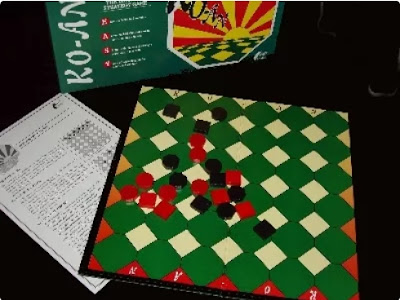Fox Games: part 2
Fox games are not only from Europe. There are board games with asymmetrical forces in other places.
A well-known traditional game is Baghchal from Nepal,
As BGG reviews:
At the start of the game, there are four tigers on the board while there are no goats. The goat player places his/her pieces on the board one by one wherever they choose, with the tiger player getting a move between each placing. Once all the goats are on the board, the two players take turns moving one of their pieces one space. A tiger can alternatively capture a single goat by jumping over it in a line to an empty space. The tigers win if they can capture five goats. The goal for the goats (who cannot make captures) is to hem the tigers in, giving them no opportunity to move or jump.
Other traditional examples are
- Diviyan Keliya (Leopards and Cows) played in India and Sri Lanka
- The medieval Cercar la Liebre (Catch the Hare) played in Spain, which derived to Coyote played in Mexico c.19th century
- Len Choa (Len Cua Kin Ngoa) from Thailand [1]
- Komikan (El Leoncito) from Chile with a first known reference from 1787 [2]
This ludeme is just too simple and attractive and continues to be used in modern games.
One example is 1975's Buffalo Chess (aka Bison) from Alex Randolph.
Ludii description:
Buffalos move one step forward to a free space. Dogs move like a chess queen but cannot capture. The villager moves like a chess king, and can capture buffalos. Dogs and the villager cannot enter the top or bottom rows of the board. Buffalos start, and win by reaching the top row. They lose if they cannot move anymore.
Another (less well-known) example is 1970 Carapace (aka Revanche):
The board is, in essence, hexagonal. The asymmetry here is more pronounced, where one player will win for sure. The adversary goal is resistance. A game consists of two matches, where players switch sides. Some spaces have extra value (check the number of dots in the previous board) that are used for scoring. Wins the player with the better score.
Steve Sisk wrote the next rules:
The tame geese move one step orthogonally, while the wild goose is unable to capture, but moves like a Queen and is also able to fly to the adversary's first row. The geese have 15 turns to capture it. There's a ZRF to play it.
[1] Captain James Low, On Siamese Literature, Asiatic Researches vol.20[2] (1839)
[2] Thierry Depaulis, Inca Dice and Board Games, Board Games Studies 1 (1998)
















































